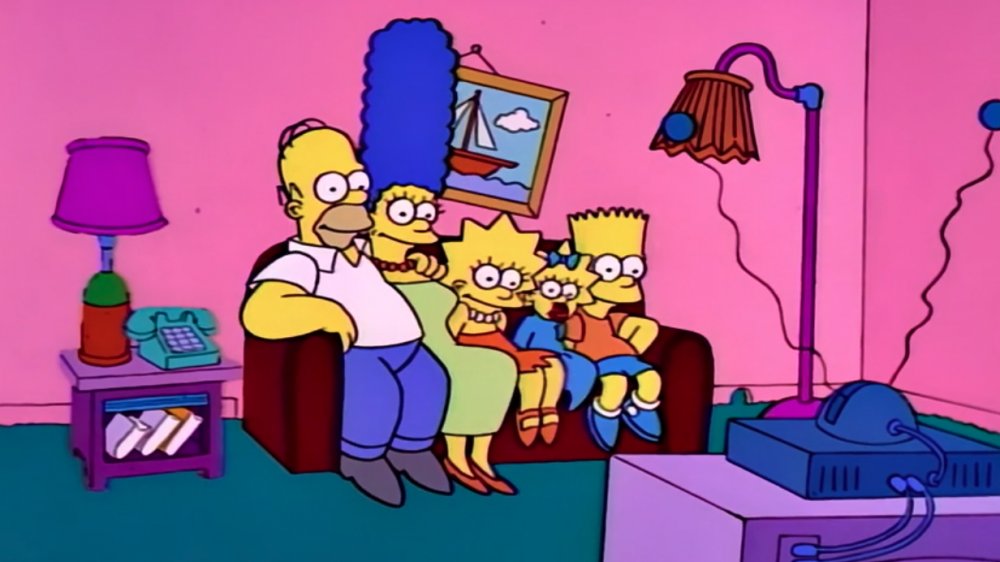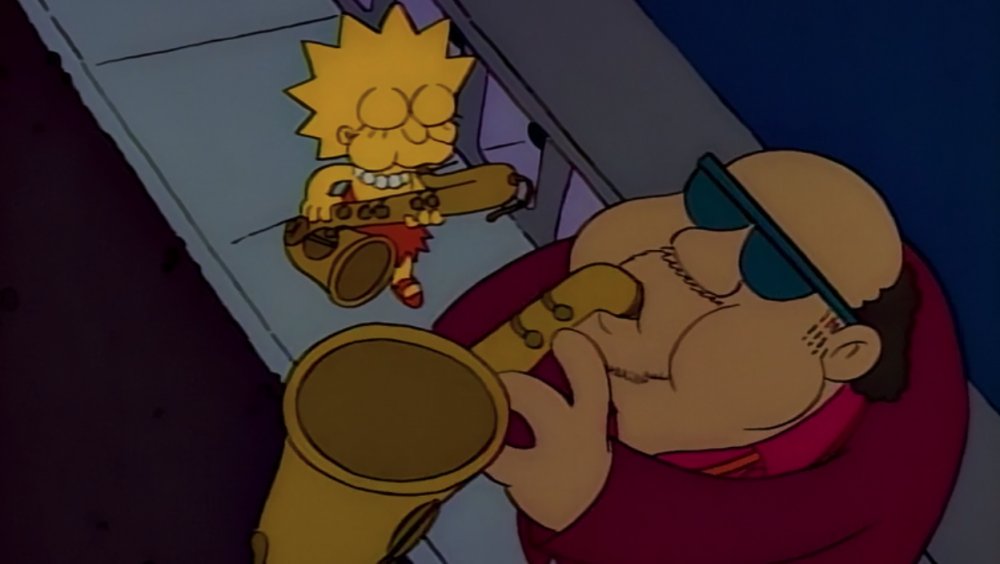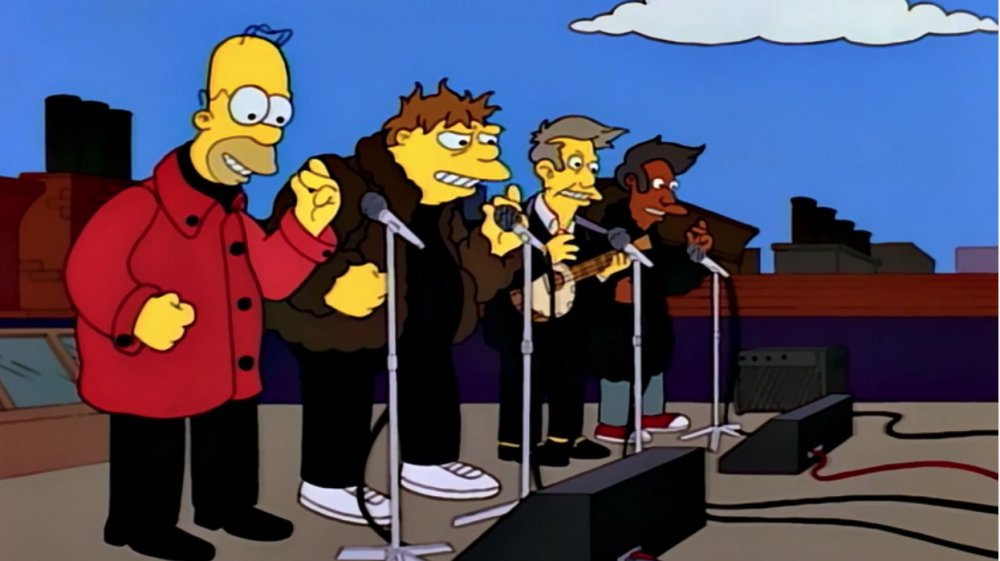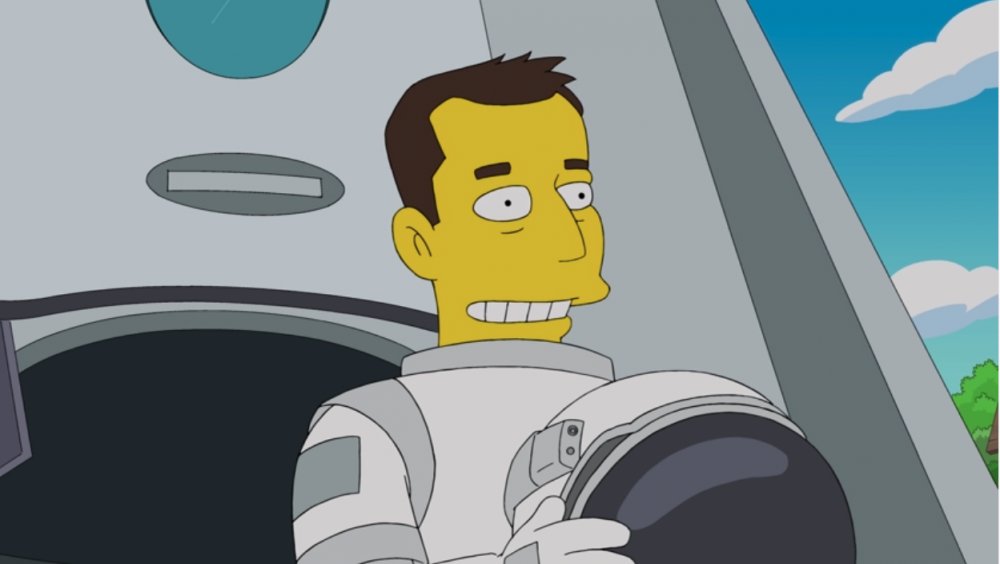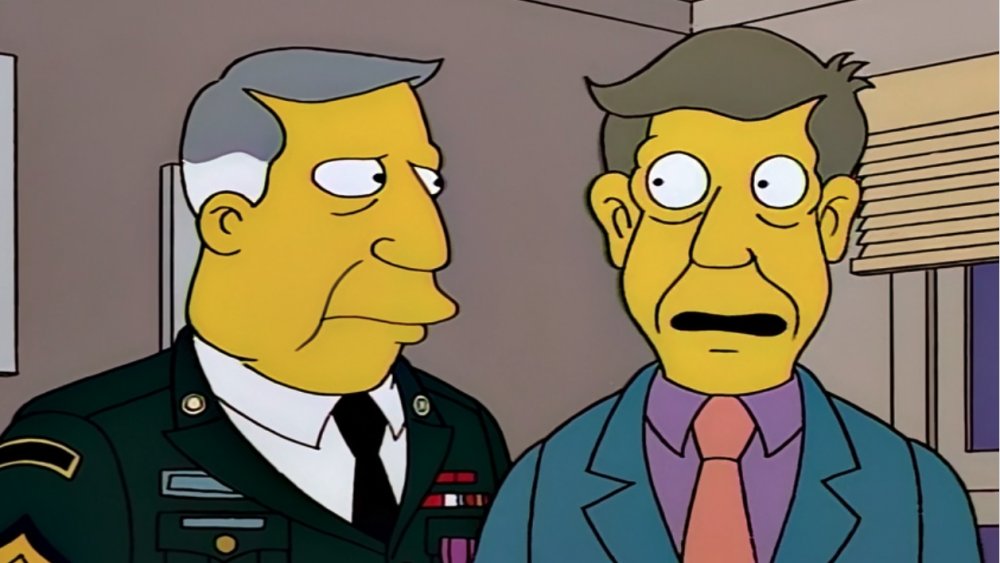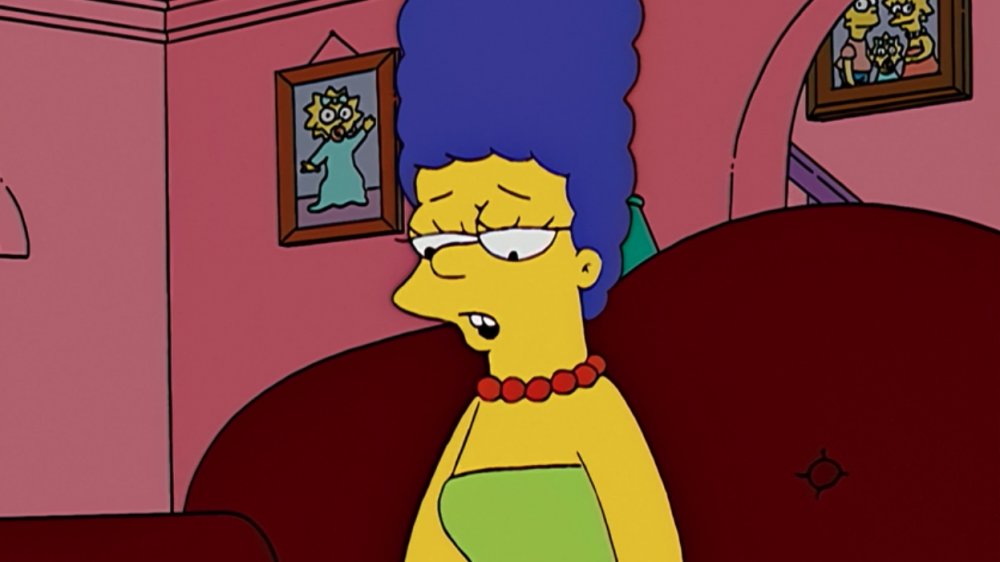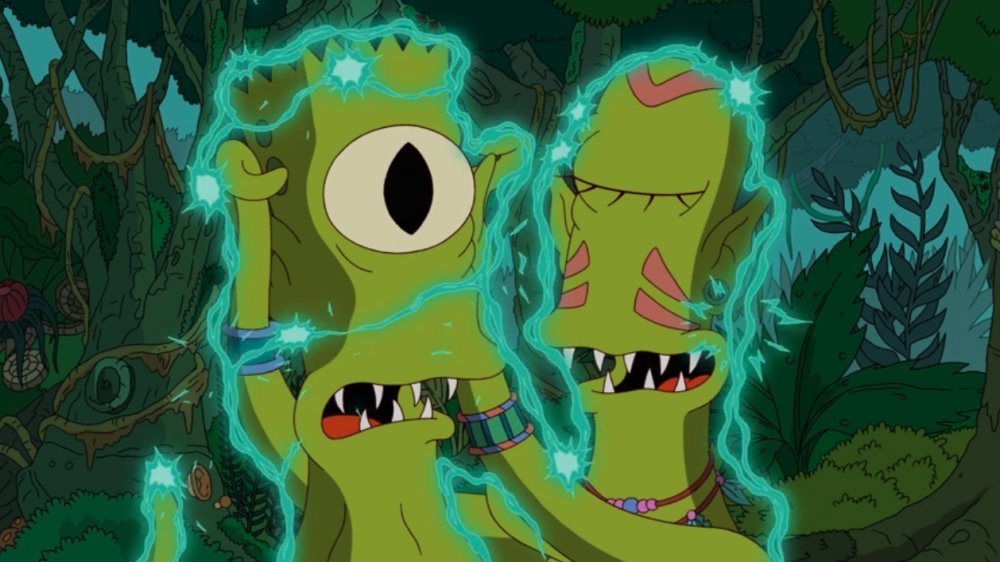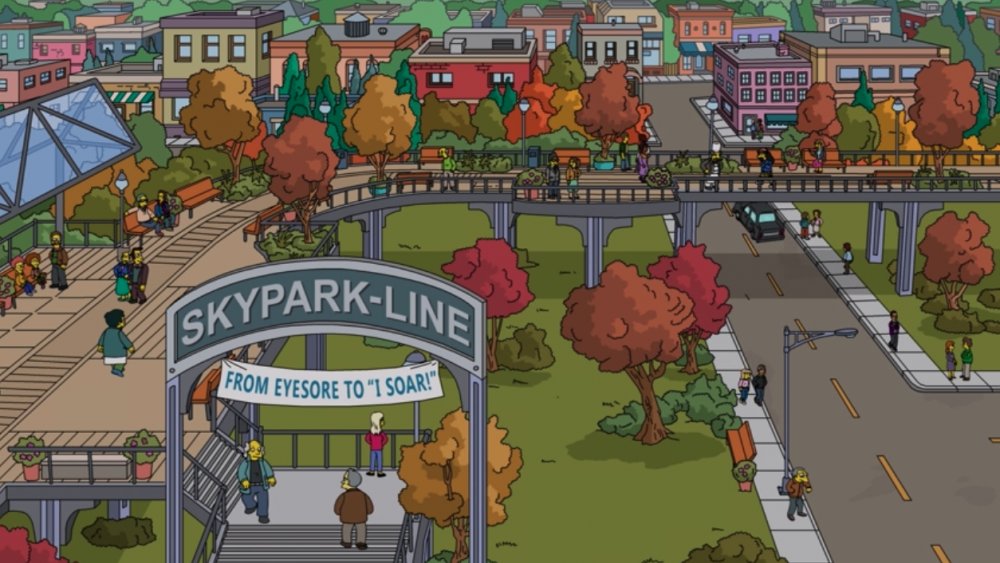The Real Reason The Simpsons Became So Repetitive
One of the longest-running series on television, The Simpsons premiered in 1989 and has continued to run ever since. To say that the show has been a pop culture phenomenon would actually be selling it short. For the '90s and early 2000s, the show was pop culture. Everything that mattered was mocked by The Simpsons, and the show became iconic for its biting humor, social commentary, and its various references and background gags.
But over time, the titular family and the enormous cast of characters that make up the town of Springfield have become older than a sizable chunk of the world's current population. And in recent years, the show has lost its luster. After so many seasons, fans have complained of a quality drop, and critics have stopped taking the show seriously. Now that the series is on Disney+ in its entirety, it's easier than ever to watch its rise and fall. In a vacuum, the show never really gets bad per se, but it does get pretty repetitive, and the reasons why are numerous.
The characters on The Simpsons never grow or change
While three decades makes a huge difference in the real world, in the weird world of The Simpsons, it hasn't meant much. Since the show is animated, the characters can stay the same age indefinitely. In fact, long-time producer Al Jean hammered this home in early 2020 when he tweeted that since Homer was still 39 years old as of season 31, that makes his birth year 1980. What makes that remarkable is that 1980 was Bart's birth year way back in season one.
If the characters on the show aged normally, Bart would be Homer's age, and Homer would be closer to Grampa Simpson's age. Much of the cast was in their 20s or early 30s when the show began, meaning most of them are around 60 now. Harry Shearer — who voices Principal Skinner, Ned Flanders, Mr. Burns, and many more — is now 76. It's pretty staggering how so much time has passed in the real world, but none has passed at all in Springfield.
Even if you count every episode as a single day (which doesn't really work as most take place over days, weeks, or even months), almost two years should've passed, but it hasn't. Bart and Lisa are still in the fourth and second grade, respectively. While this is an artistic decision, it's definitely a big contributor to fans feeling like the show has been treading water.
The show began recycling old themes
Because the characters don't ever change in The Simpsons, that also means they keep having the exact same problems, over and over again. Homer is awful at his job and gets fired multiple times a season, not to mention having to constantly learn and relearn how to be a decent husband or father. Bart has to discover that he's not all bad so many times that it's almost like he's stuck in some sort of purgatory where he has to repeat his mistakes for eternity. Lisa regularly features in episodes where she has doubts about her intelligence or her saxophone skills, despite her frequently matching wits with some of the smartest people alive and playing alongside award-winning musicians on a regular basis.
Even the titles get recycled. The show has had four different episodes with titles that were puns on the Mona Lisa — "Moaning Lisa," "Moe'N'a Lisa," "Mona Leaves-a," and "Loan-a Lisa." Only one of those episodes isn't about Lisa being disappointed in someone. It's one thing to have a long-term struggle with something — it happens in real life all the time — but it's another thing entirely when you can't learn from all your previous experiences. Real people learn from their past, and when a similar problem comes around, they can draw upon those experiences. Unfortunately, this doesn't seem to be an option for the people living in Springfield
The show was careless about continuity
In a half-hour animated comedy, it's likely that continuity isn't going to be a priority and understandably so. While that's frustrating and also leads to The Simpsons being repetitive, it's not as annoying as the show disregarding what little continuity it had. The most infamous example of this is the season nine episode "The Principal and the Pauper," in which Principal Skinner is revealed as a fraud who stole the identity of the real Seymour Skinner, who was presumed dead. Armin Tamzarian, the man who's been posing as Skinner, is exposed when it turns out that the real Skinner actually survived.
That particular episode ends with a pretty clear message that the story isn't meant to be taken seriously, as the townspeople agree to keep referring to Tamzarian as Skinner and to never speak of any of it again. But even though the episode is never brought back up, this little twist majorly affects some earlier episodes.
For example, the season seven episode "Raging Abe Simpson and His Grumbling Grandson in 'The Curse of the Flying Hellfish'" has Grampa Simpson serving in World War II with Skinner's grandfather, who looks and sounds exactly like the Skinner we'd seen every week up to that point. Worse, in that same episode, Grampa is depicted as older than Mr. Burns, despite being somewhere in his 80s and with Burns repeatedly said to be over 100. While not huge issues, the weak continuity has nevertheless led to fans feeling disappointed.
The early seasons were too good
One of the things that made later seasons of The Simpsons feel "not-as-good" is that, well, they're kinda not. Granted, when compared to your average TV show, they might not seem all that bad. And indeed, many are perfectly fine if viewed in a vacuum, minus a few bad episodes. In fact, when compared to any other sitcom of the last 30 years, that's actually pretty respectable. After all, every show falters sometimes.
What makes The Simpsons appear to have a major quality drop is that the first several seasons are some of the best television of the '90s, full of iconic episodes that pop culture still reveres decades after. Think of favorite episodes like "Marge vs. the Monorail" or "Homer's Barbershop Quartet," episodes that defined not just the show but comedy in general. You still see memes and references to early Simpsons episodes just about every single day.
It's hard to catch lightning in a bottle, but The Simpsons managed to do it over and over again for years. That almost never happens with any kind of media, and it's incredible that the show's creators were able to keep things so good for so long. But it's not sustainable forever, and the show was bound to have ups and downs. They hit such a high point right out of the gate that even "good" can't hold a candle to great, making it seem lesser or even like a failure.
Characters on The Simpsons have become parodies of themselves
Sometimes TV shows, especially comedies, will take one aspect of a character and, over time, build it up to the point that it's the cornerstone of their personality. This phenomenon is called Flanderization on TV Tropes, and it is, of course, named after the Simpsons' neighbor, Ned Flanders. Early seasons showed him to be a friendly neighbor who happened to be religious. Over time, though, Flanders' religion came to define who he was and how he reacted to everything. It eventually just became his whole identity.
While the trope is named after Flanders, a greater example is Homer Simpson himself. In early seasons, he was sloppy, short-tempered, and fairly stupid, but really, he was a family man who cared deeply about the people he loved. Over time, though, the show has turned more toward emphasizing Homer's idiocy and less his family man personality. He gets more involved in shady schemes or foolish ventures, and Homer has even becomes a downright selfish jerk on many occasions.
This can be seen in other characters such as Krusty, who goes from a well-meaning children's performer with personal problems to a greedy crook who's outright antagonistic toward kids. Mr. Burns starts as a typical heartless boss and transitions into a Lex Luthor-type supervillain. Principal Skinner goes from an earnest but boring educator to a co-dependent weirdo. These characters lost their nuance and became less rich and interesting.
31 seasons is a whole lot
When it comes to sitcoms, 31 seasons and nearly 700 episodes is unprecedented, and it makes The Simpsons one of the longest-running series ever ... inevitably causing a shortage of new stories. Okay, granted, there's no genuinely "new" story. But at its roots, all human storytelling is made up of components from previous stories, then presented in new ways. As a result, certain themes and ideas run throughout every single tale, but while the basics might be the same, the packaging can be different and unique. That way, TV shows can use the same story structure to create interesting new episodes.
The same could be said of The Simpsons, but it doesn't work out that way because it's a half-hour show with no real continuity. Because things never change and there's only so much time to tell a story, The Simpsons is hamstrung on where it can reasonably go with its plots. Each episode must be self-contained, and then the plot has to be set up and resolved in about 22 minutes, if commercials aren't taken into account. This leads to episodes with similar themes feeling like re-hashes.
For example, in "The Great Wife Hope," Marge finds MMA fighting to be too violent and tries to put a stop to it. It greatly resembles a much earlier episode, "Itchy & Scratchy & Marge," where Marge finds The Itchy and Scratchy Show to be too violent and tries to put a stop to it. The details are different, but the overall theme of the episode is the same.
The Simpsons relies too much on celebrity guests
One of The Simpsons' biggest draws over the years has been its variety of celebrity guests. Numerous pop culture icons have been featured on the show, from Leonard Nimoy and Stephen Hawking to Paul McCartney and Aerosmith. There are many excellent episodes with celebrity voices in them, like season three's "Stark Raving Dad", which features Michael Jackson, under a pseudonym, playing a character pretending to be Michael Jackson.
But while there are several examples of great episodes with famous guest stars, there are also a lot that seem to have started with the studio booking the guest and then the writers struggling to figure out a story with them that makes sense. For example, there's "Lisa Goes Gaga," where Lady Gaga comes to Springfield and, for some reason, decides to try really hard to cheer up Lisa.
One of the more bizarre examples of this is the episode "The Musk Who Fell to Earth," an entire episode about inventor Elon Musk who finds Homer's disparate and ridiculous thoughts to somehow be inspiring. As The A.V. Club noted in their review, the episode feels more like a love letter to Musk with the Simpson family crammed into it. It's especially odd now that the public's perception of Musk is far less glowing than it was a few years ago.
Fan backlash made the show afraid to take leaps
"The Principal and the Pauper," the controversial episode where Principal Skinner is revealed as an impostor, is notoriously considered one of the worst episodes of the show and a turning point for the series' reputation. It was instantly reviled by fans and panned by critics. It may have also had an unintentional side effect: making the show's creators afraid to try new things.
Earlier seasons of the show were more willing to experiment with characters and their stories, leading to episodes like "Homer's Barbershop Quartet." After "The Principal and the Pauper," though, you see fewer and fewer episodes that stray very far from established character storylines, meaning less innovation. While "The Principal and the Pauper" arguably went pretty overboard with changing things up, the backlash ensured that the show never even came close to trying to reinvent a character again.
It never made sense to throw away nearly a decade of fans' attachment to the character of Skinner only to have the rug pulled out from under them, but new storylines could've carried the show a lot further than retreating back into ensuring that nothing ever changes.
Characters have become stagnant
While some characters underwent the Flanderization process and thus changed to at least an artificial degree, other characters on the show have been woefully stagnant, namely the members of the Simpson household. For example, Lisa Simpson became an eco-conscious, vegetarian Buddhist very early in the show's run and then just ... stopped. Those are all fine things to be, but few people stay exactly the same for 30 years. Maybe Lisa's views could've become more nuanced over time, or she could've even learned that some of her choices may not be right for her as she grows older. After all, how many eight-year-olds know exactly who they're going to be for the rest of their lives?
Marge is another example of this. She's hardly changed at all over the decades besides some rarely touched-on issues with gambling addiction. She's still the typical American mom of the '80s, even when our ideas of what the role of a parent should be have greatly expanded. This is especially stark when compared to Homer, who's become ruder and more uncaring. Because Marge stays the same as Homer grows worse, the show has to stretch further and further to explain why she's continually willing to put up with him. This is also the case with numerous background characters. Basically, anyone who doesn't get Flanderized into playing up their worst aspects becomes perpetually stuck in time.
The Simpsons' problem with technology and pop culture
One thing The Simpsons has embraced is technology changing our lives. Over the years, the characters began owning computers, connecting to the internet, and eventually getting smartphones, often without fanfare. Much like real life, tech doesn't just one day appear — it just slowly becomes more and more important to us.
But a major thing the show has failed at is coming up with stories that use this new technology. A great many episodes involving tech are re-hashes of old stories, like "The D'oh-cial Network," where Lisa becomes a popular social media influencer. The students at school begin to like and respect her more, but Lisa can't handle the pressure and inevitably returns to being a nerd. If this sounds familiar, it's because it's exactly like a number of other episodes with similar plots, just without the social media angle.
Another example of poorly implementing changes in real life comes in the form of the show's pop culture parodies. These worked well in earlier seasons because they were often drawn from older properties and offered new insight. However, later seasons have used more recent phenomena, which often involves just replacing characters from the original property with Simpsons characters and changing nothing else. A good example of this is in "Treehouse of Horror XXII," which features a segment parodying 2009's Avatar, but it's essentially a straight retelling of the movie, with no added commentary or insight into it.
Springfield never changes
Not only do the characters of The Simpsons never really change, the city they live in also perpetually stays the same. While your average American city might see numerous changes over three decades due to new leadership and people moving in or out, Springfield really doesn't have that and continues to resemble the 1990s ideal of small towns. Maybe Mayor Quimby just really loves things exactly how they are.
Even new constructions are often forgotten about by the following week, and new businesses are never mentioned again. In one notable exception, after 25 years, the Springfield Monorail reappears in season 29's "The Old Blue Mayor Ain't What She Used to Be" when the town uses its ruins to build a new elevated park above the city. Naturally, the park hasn't been seen again since.
This also means the denizens of Springfield repeatedly make the same mistakes when it comes to town emergencies. While the show occasionally lampshades this by making jokes about how short-sighted and foolish the people of Springfield are, the reality is that we see the town go through the same motions again and again whenever a new crisis emerges. Characters not being able to utilize past experiences to react more wisely to future problems is one thing, but an entire town full of these people can get pretty exhausting over time.
The Simpsons has backtracked on the few changes it's made
The Simpsons slowed down on making big changes after "The Principal and the Pauper," but they did make a few here or there. But in pretty much every single case, the changes were eventually undone by the show's writers, setting things back to zero again.
For example, Milhouse's parents divorced, which led to some insightful moments about Milhouse and his family adjusting to this new reality. After several seasons, though, despite neither character actually changing, his parents remarried. Speaking of getting hitched, Apu was wed in an arranged marriage, introducing his wife Manjula and later their eight children, which gave him a bit more depth before the show reverted him to a one-note character, rarely mentioning his family, then writing him out entirely after 2017's The Problem with Apu. Even Barney briefly got sober and became a helicopter pilot, but the show dropped this and returned him to being a shiftless alcoholic not long after.
Stranger still, several dead characters didn't stay dead. Dr. Nick Riviera is killed in The Simpsons Movie, but he returned to the show with no serious mention of his passing. Italian mobster stereotype Fat Tony dies in "Donnie Fatso," but he's replaced with his athletic but otherwise identical cousin Fit Tony, who gains weight and becomes known as Fat Tony in a montage at the very end of the same episode, completely undoing the character's death.

